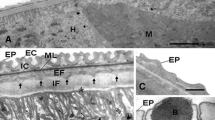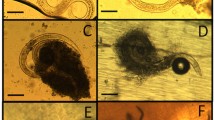Abstract
The study of the pharynx in the nematode Metarhabditis andrassyana (Tahseen et al. in Int J Nematol 14:163–168, 2004) revealed that the activity of pharynx declined with age and was also reduced in the absence of E.coli. A comparison between presence and absence of bacteria in the same age group revealed a reduction of pharyngeal pumping in both 2-day-old individuals and 8-day-old individuals. However, when nematodes were placed together in groups of varying numbers, pharyngeal pulsations declined as the numbers of specimens increased from 5 to 15 in the presence or absence of bacteria as a food source with age. In old worms, abnormalities were observed in the structure of the pharynx. Various structural changes occurred on the surface of the pharynx as well as in the lumen, tissues and the grinder. The deteriorative changes in the basal bulb reveal an involvement of almost all regions of the bulb—the outer surface, muscles and the grinder.






Similar content being viewed by others
References
Avery L (1993) Motor neuron M3 controls pharyngeal muscle relaxation timing in Caenorhabditis elegans. J Exp Biol 175:283–297
Avery L, Horvitz HR (1987) A cell that dies during wildtype C. elegans development can function as a neuron in a ced-3 mutant. Cell 51:1071–1078
Avery L, Horvitz HR (1989) Pharyngeal pumping continues after laser killing of the pharyngeal nervous system of C. elegans. Neuron 3:473–485
Avery L, Shtonda BB (2003) Food transport in the C.elegans pharynx. J Exp Biol 206:2441–2457. https://doi.org/10.1242/jeb.00433
Bennet-Clark HC (1976) Mechanics of nematode feeding. In: the Organization of Nematodes (N.A. Croll, ed.). Academic Press, London, New York, San Francisco. pp. 313–342
Bolanowski MA, Russell RL, Jacobson LA (1981) Quantitative measures of ageing in the nematode C. elegans I. Population and longitudinal studies of two behavioural parameters. Mechan Ageing Develop 15(3):279–295
Chiang JT, Steciuk M, Shtonda B, Avery L (2006) Evolution of pharyngeal behaviors and neuronal functions in free-living soil nematodes. J Exp Biol 209:1859–1873
Chow DK, Glenn CF, Johnston JL, Goldberg IG, Wolkow CA (2006) Sarcopenia in the Caenorhabditis elegans pharynx correlates with muscle contraction rate over lifespan. Exp Gerontol 41(3):252–260
Croll NA, Smith JM (1978) Integrated behavior in the feeding phase of Caenorhabditiselegans (Nematoda). J Zool (London) 184:507–517. https://doi.org/10.1111/j.1469-7978.1978.tb03304x
Doncaster CC (1962) Nematode feeding mechanisms. I Observations on Rhabditis and Pelodera. Nematologica 8:313–320
Flegg JJM (1967) Extraction of Xiphinema and Longidorus species from soil by a modification of Cobb’s decanting and sieving technique. Ann Appl Biol 60:420–437
Fürst Von Lieven A (2003) Functional morphology and evolutionary origin of the three part pharynx in nematodes. Zoology 106:183–201
Garigan D, Hsu A-L, Graser AG, Kamath RS, Ahringer J, Kenyon C (2002) Genetic analysis of tissue aging in Caenorhabditis elegans: a role for heat-shockfactor and bacterial proliferation. Genetics 161(3):1101–1112
Glenn CF, Chow DK, David L, Cooke CA, Gami MS, Iser WB, Hanselman KB, Goldberg IG, Wolkow CA (2005) Behavioral deficits during early stages of aging in Caenorhabditis elegans result from locomotory deficits possibly linked to muscle frailty. The journals of gerontology. Series A Biol Sci Med Sci 59:1251–1260
Harris JE, Crofton HD (1957) Structure and function in the nematodes: Internal pressure and cuticular structure in Ascaris. J Exp Biol 34:116–130
Herndon LA, Schmeissner PJ, Dudaronek JM, Brown PA, Listner KM, Sakano Y, Paupard MC, Hall DH, Driscoll M (2002) Stochastic and genetic factors influence tissue-specific decline in ageing C. elegans. Nature. 419(6909):808–814. https://doi.org/10.1038/nature01135
Horvitz HR, Chalfie M, Trent C, Sulston JE (1982) Serotonin and Octoamine in the nematode Caenorhabditis elegans. Science 216(4549):1012–1014. https://doi.org/10.1126/science.6805073
Huang C, Xiong C, Kornfeld K (2004) Measurements of age-related changes of physiological processes that predict lifespan of Caenorhabditis elegans. Proc Natl Acad Sci USA 101(21):8084–8089. https://doi.org/10.1073/pnas.0400848101
Johnson TE (1987) Aging can be genetically dissected into component processes using long-lived lines of Caenorhabditis elegans. Proc Natl Acad Sci 84:3777–3781
Kenyon C, Chang J, Gensch E, Rudner A, Tabtiang RA (1993) C. elegans mutant that lives twice as long as wild type. Nature. 366(6454):461–464. https://doi.org/10.1038/366461a0
Seymour M, Wright KA, Doncaster CC (1983) The action of the anterior feeding apparatus of Caenorhabditis elegans (Nematoda: Rhabditida). J Zool London 201:527–539
Tahseen Q, Hussain A, Tomar V, Shah A, Jairajpuri MS (2004) Description of Metarhabditis andrassyana gen. n., sp. N. (Nematoda: Rhabditidae) from India. Int J Nematol 14:163–168
Wu ZQ, Li K, Ma JK, Li ZJ (2019) Effects of ethanol intake on anti-oxidant responses and the lifespan of Caenorhabditis elegans. CyTA J Food 17:288–296
Acknowledgements
The financial assistance provided by the University Grants Commission (UGC) to the first author (HF) is gratefully acknowledged.
Author information
Authors and Affiliations
Contributions
HF conducted the experimental work and wrote the manuscript, while IA helped to develop the study design and with manuscript editing.
Corresponding author
Ethics declarations
Competing interests
The authors declare no competing interests.
Ethical statement
There was no need for ethical approval for using nematode as model.
Additional information
Publisher's Note
Springer Nature remains neutral with regard to jurisdictional claims in published maps and institutional affiliations.
Rights and permissions
Springer Nature or its licensor (e.g. a society or other partner) holds exclusive rights to this article under a publishing agreement with the author(s) or other rightsholder(s); author self-archiving of the accepted manuscript version of this article is solely governed by the terms of such publishing agreement and applicable law.
About this article
Cite this article
Fatima, H., Ahmad, I. Effect of age on the structure and activity of the pharynx of the free-living nematode Metarhabditis andrassyana (Rhabditidae). Zoomorphology 142, 27–33 (2023). https://doi.org/10.1007/s00435-022-00581-5
Received:
Revised:
Accepted:
Published:
Issue Date:
DOI: https://doi.org/10.1007/s00435-022-00581-5




